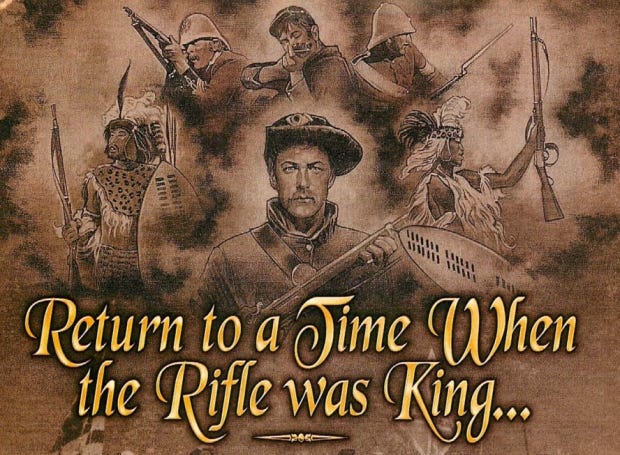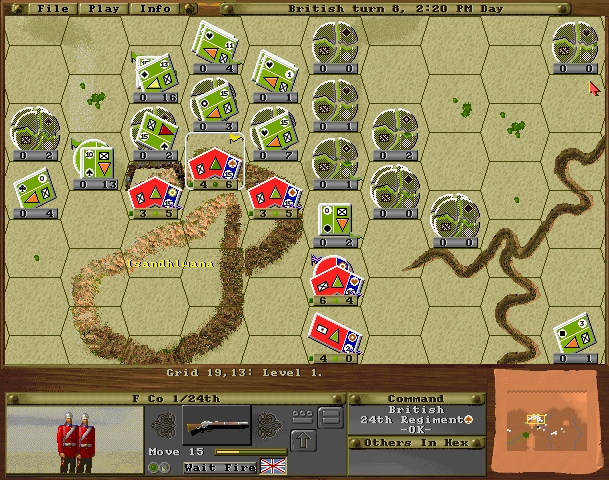The Flare Path Invites You To...
Victoriana Valued Here
(With apologies to Rudyard Kipling)
I've fought many wargames acrost the years,
An' some of 'em was good an' some was not;
But when it comes to 'exes an' new frontiers,
Koger's Age o' Rifles was the finest o' the lot.
It's a daisy, it's a ducky, it's a lamb,
It's an injia-rubber idiot on the spree,
It's the on'y title that doesn't give a damn
For a Regiment o' British Infantree!
So 'ere's to you, Age o' Rifles, an' your battles so diverse;
Though you're o'er-bloody, an' your retreats can be perverse,
I gives you your certificate, an' if you want it signed,
I'll come an' 'ave a romp with you whenever you're inclined.
For most PC wargame designers the Nineteenth Century consists of just sixteen years – 1803 to 1815 and 1861 to 1865. It's been two decades since a dev rifled the period's less fashionable conflicts with any real enthusiasm. It's been two decades since Norm Koger and SSI gave us the vast, pungently scented battle bazaar that is Wargame Construction Set III: Age of Rifles.
The three-part series acquired its reputation for exotic scenario selections early. The first instalment, the Roger Damon designed Wargame Construction Set (1986), demonstrated the flexibility of its map, unit and engagement editors with a small but eclectic set of ready-made scraps. Players could skirmish for asteroid mines, assault medieval keeps, raid terrorist training camps, plug the Fulda Gap, and re-fight the Battles of the Bulge and First Bull Run without ever leaving the confines of the software. Malleable map scales, movement rates, and weapon ranges meant a tile that might represent 20x20 metres of sun-baked dirt in an Old West tussle, could represent 2000x2000 metres of grassy steppe in an Operation Barbarossa one.
While the scenarios that shipped with the sequel, WCS II: Tanks! (Koger, 1994), were all Twentieth Century affairs and the hex size was fixed at 250m, cosmopolitanism and customisability remained key attractions. Infantry-rich (the title was a tad misleading) WW1, Korean War, Operation Desert Storm and Arab-Israeli clashes rubbed epaulettes with a generous supply of WW2 outings. If the scenarios ever began to pale, there was a random battle generator and a clutch of editors waiting in reserve. Ointment flies were relatively few, but implausibly high bodycounts and the fact that badly mauled units wouldn't automatically retreat, did dent review scores in some quarters.
When, in 1996, the third Wargame Construction Set arrived, the panzers and the ground attack aircraft were nowhere to be seen. Koger and co. had decamped to an era when battlefields bobbed with pith helmets, slouch hats and kepis. When lines of resolute riflemen spat lead at lines of resolute riflemen, and, sometimes, the sword and spear proved mightier than the Martini-Henry and the Gatling Gun.
Built around a commercially conservative core of American Civil War scenarios and campaigns, Age of Rifles true treasures were its editors and its African, Asian and South American battles. Amongst the 60+ included scenarios were many fascinating engagements that hadn't been PC gamed before and, with a few exceptions, haven't been PC gamed since.
Glittering like Nile Perch in AoR's extensive hexnets were pieces of the Anglo-Zulu War, the Boer Wars, the Boxer Rebellion, the Indian Mutiny, the Anglo-Afghan Wars, the Spanish-American War, the Russo-Japanese War, the Crimean War, the Madhist War, the Sioux Wars, the War of the Pacific, the Italian Wars of Independence, and the Franco-Prussian War!
Suddenly Shermans seemed awfully prosaic.
Great controls, unfussy turn structuring, and WCS1-style scaling that allowed scenario designers to alter hex size, unit size, and turn length to suit different battles, meant you didn't need to be a dyed-in-the-wool grognard with the patience of a Giant Redwood to enjoy all this exotica. Although AoR stands a few rungs higher up on the complexity ladder than its stablemate Panzer General, it radiates the same bonhomie and gallops along with a similar sense of urgency.
Few if any turnbased wargames employ the mouse better. A left click selects, deselects or fires. A right click re-orientates. Troop movement is drag and drop, a helpful annotated hex trail indicating how far a unit can go before losing the capability to fire or unlimber during the turn. If the overlay also indicated which hexes are visible from a chosen destination, it would be just about perfect.
The unit counts, like the turn limits, rarely intimidate. In the unlikely event you do tire of moving, say, Zulu impi at Isandlwana, or Hadendoa swordsmen at Omdurman, help is just a button press away. The 'orders scope' switch – something every wargame should possess - determines whether instructions apply to just the selected unit, all units in a hex (never more than two), or every unit in a multi-unit 'command'.
Koger syncopates potentially monotonous IGO-UGO rhythms with an inspired initiative system and peppery player-modifiable reaction fire mechanics. It's never certain which side is going to act first in any turn, and every manoeuvre or fusillade invites instant automatic retribution. Troops can be instructed to hold fire during the enemy's phase, engage at a specific range, or, in the case of cavalry, commence a charge. Scared or inexperienced soldiery may ignore these Standard Operating Procedures, unauthorised 'frantic fire' sessions depleting ammo and reducing available action points for the coming turn.
By putting morale at the heart of the design, and disrupting the attritional to-and-fro with unpredictable reactive behaviours, enough chaos is injected into combat to keep brows beaded and brains busy, and mask the minor deficiencies of a dogged but unimaginative AI. As in the easy-to-recommend Pike & Shot spin-off Sengoku Jidai, the chance demise of a charismatic leader - a Gonville Bromhead or a Dabulamanzi kaMpande – sometimes has far-reaching consequences. Under the dead man's automatically promoted replacement, the next retreat check is failed. Neighbouring companies seeing their comrades withdrawing, lose their nerve too. Before you know it, your carefully engineered defensive perimeter is in tatters.
Just as important as where you put your men and what you tell them to do in the event of enemy contact, is how you arrange them within their hexes. The seven formation types - attack column, supported line, line, march column, defensive, square, and disordered – the first three of which can be employed with or without skirmishers, all impact mobility, vulnerability, and fire and melee efficiency. A march column that finds itself under close-range fire from a line of well armed, well trained and well rested opponents is in for a fearful licking. Perhaps too fearful.
Given that this is a game stuffed with simmy subtleties (I've yet to mention dynamic weather and light levels, friendly fire, stragglers, fatigue and flammable terrain) it's a little odd more effort wasn't put into ensuring combat algorithms produced plausible bodycounts. In a sense it doesn't matter if death-tolls are outlandishly high on occasion (Which they are. Melee can be particularly brutal) as both sides are subject to the same martial maths, and routs are always far more common than extinctions. That said, if AoR ever gets the refurbishment and re-release it so richly deserves, the updated version simply must have a lethality slider nestling somewhere in its options screens.
And my 'The Curse of the Salt Sarcophagus' battle sequence in its campaigns folder.
In addition to shipping with arguably the most interesting selection of battles ever to grace an off-the-shelf wargame, AoR came with some of the genre's most capable editors. Not only is making maps, scenarios, and scenario chains a piece of perfectly moist Dundee cake, you're free to populate your hand-made creations with units you've named, stat-endowed, and dressed yourself. Keep this to yourself, but Age of Rifles' toughest decisions aren't military, they're millinery. Keeping Rorke's Drift Zulu free is child's play compared to choosing perfect headgear for a Victorian railway engineer-turned-mummy-fighter from a selection of 120 different hats.
* * * * *























